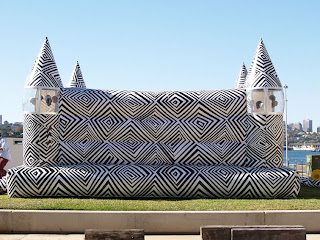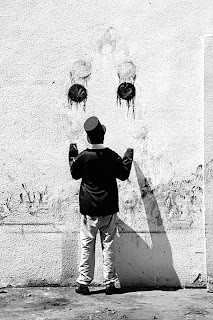Apologies for the break nos chers lecteurs, even bloggers have to have holidays. Normally we try not be retrospective, but unavoidably this is something of a rear-view take on some Sydney exhibitions that caught our eye from late 2009 into 2010. We'll try to be more current in future.
MCA SYDNEY: SPRING/SUMMER 09/10
- Olafur Eliasson Take Your Time
- Fiona Foley Forbidden
- Making it New: Focus on Australian Contemporary Art
- Primavera 2009
- Almanac, the Gift of Ann Lewis AO
- Louis Bufardeci & Zon Ito
- Avoiding Myth and Message: Australian Artists and the Literary World
It has been a strong season for the MCA, with a good blend of local and international offerings, and none of them too obvious.

Above: © Olafur Eliasson.
360° room for all colours (2002) courtesy the artist and SFMoMA.
Eliasson (Denmark/Iceland) is of course approaching art megastar status, and it's the sort of international contemporary one-person survey show (initiated by San Francisco MoMA in 2007 and already seen at NY MoMA and MCA Chicago in 2008) at which the MCA excels - a youngish artist of great international interest, but not yet a household name. It is one of the few Australian institutions to do this, with some credit also to AGNSW, GOMA and NGV.
Eliasson is famously anal, demanding and precise, and it has to be said that the production/installation values of this show are fabulous. This particular body of work, dating from the early to mid noughties, is all about precision and the 'science' of light, yet it delivers quite playful results, sometimes merely interesting, at times poetic and transporting. The absolute standout piece for us is one of the less 'optical' ones, Beauty (1993), achieved by projecting dim white light through a fine mist of falling water in a darkened space. While obviously an installation challenge for the electricians, the work is very simple in execution and effect – a wraith-like 'entity' dances just above floor level, a hallucinatory will-o-the-wisp. This piece is one of the few in this exhibition that gives the clue to Eliasson's wider preoccupations with natural phenomena, and that is a pity, because at his best he is an artist that can deliver an almost theatrical magic and, like Andy Goldsworthy, a simple wonder at the beauty of the elements.
At Primavera, Michaela Glaeve's Cloud Field (2007), explored similar territory, though with less vivid effect, possibly because the space, with a fine mist rising from jets at floor level, was brightly lit. Christine Eid's installation Your Place (2006) featuring taxi-top lights with various Anglo and Middle-Eastern names was another memorable piece. Whatever one may think of individual Primavera selections (09 was curated by Jeff Khan), they are always worth seeing and a good MCA tradition.
As is the (biennial) Focus on Contemporary Australian Art (FOCAA) series, of which this was the fourth installment, curated in-house by the recently appointed Glenn Barkly. Unlike Primavera, which features only artists under 35, FOCAA has a mix of old and new, emergent and venerable. Featured in Making it New were Alison Alder, Micky Allan, Jon Campbell, Lou Hubbard, Matthew Hunt, Bob Jenyns, Linda Marrinon, Archie Moore, Tom Moore, Marrnyula Mununggurr, Raquel Ormella, Alwin Reamillo, Khaled Sabsabi, Neil Taylor, Ken Thaiday Snr, Ruth Waller, Toni Warburton and Ken Whisson. This was a very strong show, with our standouts being Neil Taylor, Bob Jenyns and Micky Allen.
Fiona Foley's recently-closed mid-career retrospective Forbidden was also very solid, but somehow failed to be more than that. She is an artist working across a wide repertoire of contemporary media, and it's appropriate for a survey show to cover the gamut, but therein lies the problem - it fails to satisfy in the way that a more concentrated or themed body of work may do. She undoubtedly has many exciting years ahead of her. A fine independently-published book is available.
The Bufardeci/Ito collaboration was a worthy offering, and the Ann Lewis bequest is a very fine collection indeed, but very special mention is due for Avoiding Myth and Message: Australian Artists and the Literary World, featuring mainly work from the collection. For anyone curious about text in contemporary art this was a fascinating exhibition for which the catalogue is still available.
Martin Sharp, Sydney Artist
Museum of Sydney
Until 14 February, 2010
This exhibition closes soon. it feels like an age since LF attended the packed opening in late October. And quite an event it was, with the OzMag generation out in force. For quizzical bystanders that weren’t around in Sydney or London during those heady days, it was a who’s who of the era, resplendent in a flurry of silver manes, white goatees and embroidered waistcoats.
Before Mambo there was Martin Sharp. Much has been written about the show, hung salon style in that single large shoebox on the first floor, the walls painted cobalt blue for the duration. Even if you’re not a fan of Sharp’s oeuvre (and this writer is not especially), the massed Tiny Tims, Luna Parks, Harbor Bridges and Eternities achieve definite critical mass in a riot of primary colour. It’s vaguely chronological, and some of his very early work is included, offering a useful if eccentric survey of one of Australia’s most distinctive painter/designer/savants. If you ain’t seen it you should have, shame on you!
Martin Mischkulnig Smalltown
Museum of Sydney
Until 14 February, 2010
Also closing soon is this excellent photography show, the subject of a handsome book with a text by Tim Winton. Highly reminiscent of Trent Parke’s Welcome to Nowhere series (2006), this is fine stuff.
The exhibition is described ‘a dialogue between photographer Martin Mischkulnig and author Tim Winton, travelling through out-of-the-way parts of Australia’, and Winton says ‘The wild landscapes of Australia are routinely described as desolate and forbidding… [yet] for all the talk of hostility and harshness, there is nothing so bleak and forbidding in country Australia as the places humans have built there…"
The same images were also featured at the Evan Hughes Gallery in October/November 2009. The book is excellent, so if you missed the show, get that.



























